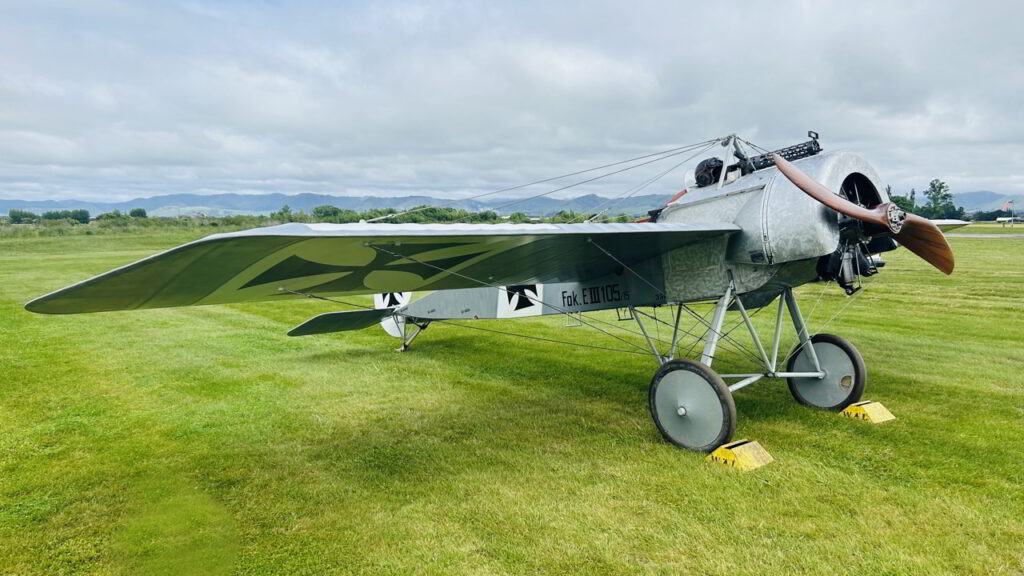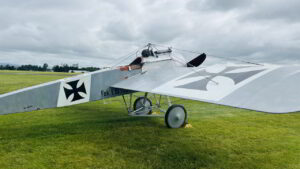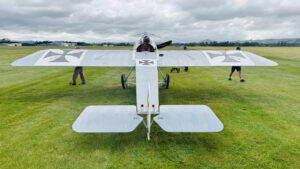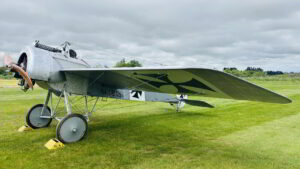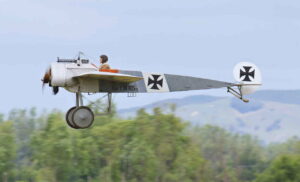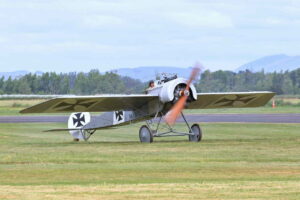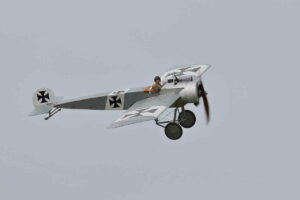By Allan Udy, Historical Aviation Film Unit
The recent Wings Over Wairarapa Air Festival at Hood Aerodrome, near Masterton in New Zealand’s North Island, experienced some challenging weather conditions during their rescheduled airshow in late 2023 (as reported by Vintage Aviation News). While the adverse conditions were not sufficiently bad to curtail all flying at the show, they did make it difficult for The Vintage Aviator Limited (TVAL) to showcase their collection of relatively fragile WWI aircraft which are based at the airfield. With an eye to safety and the preservation of these historical treasures, it was thought best to keep their aircraft grounded for the duration of the festival weekend.
![TVAL's first Fokker E.III Eindecker reproduction at rest between flights. [Photo by Historical Aviation Film Unit]](https://vintageaviationnews.com/wp-content/uploads/HAFU_Eindecker_3210_HAFU-1024x576.jpg)
This meant that the eagerly awaited public flying debut of their latest reproduction, a German Fokker Eindecker monoplane, had to be postponed. While fans of aviation history may have to wait some time for a future event to witness this remarkable aircraft take to the skies, the Historical Aviation Film Unit‘s commitment to capturing video footage of TVAL’s aircraft whenever possible means that it is possible to see how the aircraft performs and sounds, now, in the video accompanying this article. During the weekend preceding the airshow, TVAL pilot Andrew Vincent took to the air in the Eindecker a couple of times to practice a display routine for the scheduled show.
The aircraft itself, a reproduction 1915 Fokker E.III Eindecker registered ZK-EIN, is based on one of several Fokker fuselages built by Achim Engels in Germany over the past several decades. Engels produced the bare fuselages which were then purchased by TVAL and added to their aircraft production queue. The lengthy construction process for ZK-EIN has only been completed in the past twelve months, although much of the work was carried out in parallel with a second E.III which is expected to fly for the first time later in 2024. Both aircraft are powered by original 9-cylinder Gnome Monosoupape rotary engines.
Incredibly, these two Eindeckers are not the only full-size Fokker monoplanes currently in New Zealand. The two Fokker D.VIII/E.V aircraft (a 1918 design) which TVAL has been flying and displaying on a regular basis for around ten years were also built by Engels and, like the E.IIIs, were also acquired as bare airframes which needed to be completed in New Zealand. Those two aircraft are powered by authentic TVAL-built reproduction Oberursel UR.II rotary engines.
![TVAL's two Fokker D.VIII reproductions in flight. [Photo by Historical Aviation Film Unit]](https://vintageaviationnews.com/wp-content/uploads/HAFU_Eindecker_TwoDVIIIs_HAFU-1024x748.jpeg)
Furthermore, Engels himself owns three other aircraft which are currently in New Zealand. His own Fokker E.III and Fokker D.VIII, along with a Fokker D.VII biplane, were on long-term loan to The Australian Vintage Aircraft Society (TAVAS) in Caboolture, Queensland, Australia until 2030. However, TAVAS has now closed down and the two aircraft are now based at the Omaka Aviation Heritage Centre at Omaka Aerodrome near Blenheim in New Zealand’s South Island for the next five or six years. The Engels E.III at Omaka is powered by a 9-cylinder Gnome Monosoupape rotary engine reproduction built by Tony Wytenburg’s Classic Aero Machining Services (also located at Omaka) and, as with the second TVAL E.III, it’s expected that this aircraft will take to the skies once more following an engine overhaul at some stage later in 2024.
It is stunning to think that by the end of 2024, New Zealand aviation enthusiasts may be able to see at least five full-size WWI Fokker monoplane aircraft flying in New Zealand skies, all powered by authentic rotary engines. On behalf of those enthusiasts, we say “thank you, TVAL”, and “thank you, Mr Engels” for your foresight, perseverance, and dedication to constructing the fuselages that these historic aircraft are built upon.
